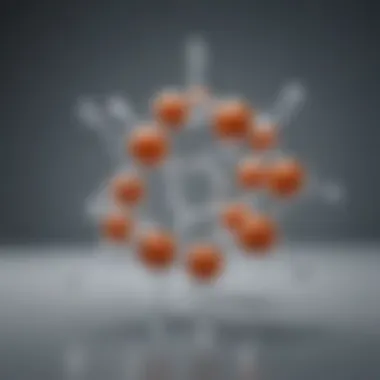Iodic Compounds: Properties, Applications, and Safety


Intro
Iodic compounds represent a unique area of study within the field of chemistry. Their significance extends beyond mere academic interest; they play crucial roles in various practical applications, ranging from medicine to environmental science. Understanding iodic compounds involves delving into their chemical properties, behaviors, and the implications they hold across multiple scientific disciplines.
The relevance of iodic substances is extensive. They are often utilized in diagnostic imaging, serve as reagents in chemical analysis, and have potential implications in environmental remediation. Given the breadth of their application, a comprehensive examination of iodic compounds is essential for both researchers and industry professionals. This article aims to provide a structured overview that highlights the importance of iodic compounds while also addressing safety considerations associated with their use.
Preamble to Iodic Compounds
Iodic compounds are a significant area of study in chemistry and related scientific fields. Their relevance is not limited to academic circles; they have practical applications in medicine, environmental science, and industry. Understanding these compounds and their properties is essential for both theoretical exploration and practical utilization.
Definition and Basic Properties
Iodic compounds predominantly consist of iodine. These compounds are often characterized by the presence of the iodate ion, IO3-. This ion tends to form salts and esters with various cations, showcasing a diverse array of chemical behaviors. Typically, iodic compounds exhibit strong oxidizing abilities, making them vital agents in numerous chemical reactions.
Some basic properties of iodic compounds include their stability under normal conditions, solubility in water, and reactivity under acidic or alkaline environments. These features lay a foundational understanding of how iodic substances interact with other chemicals. It also explains their utility in fields such as organic synthesis and analytical chemistry.
Historical Perspective
The study of iodic compounds can be traced back to the early 19th century. Iodine itself was first isolated in 1811, and subsequent research led to the discovery of iodic acid in the early 1820s. Over time, scholars recognized the significance of these compounds, especially in medicinal chemistry. For instance, iodic compounds were once used in the treatment of thyroid disorders before the commercial availability of iodized salt.
Moreover, historical discoveries have paved the way for modern applications. The understanding of iodic compounds has evolved, and today they play a crucial role in various industries, including pharmaceuticals and agriculture. Their chemical properties have inspired ongoing research, allowing scientists to explore innovative applications for iodic compounds.
Chemical Structure of Iodic Compounds
Understanding the chemical structure of iodic compounds is crucial in evaluating their behavior, properties, and applications. The arrangement of iodine atoms and their interactions with other elements define much of how these compounds function in various contexts. Iodine, being a member of the halogen family, exhibits unique bonding characteristics that influence the stability and reactivity of iodic compounds. This forms the backbone for their application in multiple scientific fields, such as medicine, environmental science, and industry.
Iodine's Role in Molecular Formation
Iodine serves as a pivotal element in the formation of iodic compounds. With its atomic number of 53, iodine's electronic configuration allows it to engage in multiple bonding scenarios. Typically, it can form covalent bonds with other non-metals like oxygen and hydrogen. The covalent bonds between iodine and oxygen yield compounds such as iodic acid, crucial in several reactions across organic and inorganic chemistry. Such properties make iodine an essential participant in molecular synthesis and are fundamental to the structural integrity of these compounds.
Through its ability to adopt various oxidation states, iodine offers remarkable versatility. For example, in iodates, iodine exists in a +5 oxidation state, while in iodides, it is in a -1 state. Understand how these states influence molecular formation can provide insights into the compound's behavior under different conditions. Moreover, recognizing iodine's electronegativity is critical, as it affects the polarity and solubility of iodic compounds in solvents, modifying their practical applications.
Variants of Iodic Compounds
The term "iodic compounds" encompasses a wide range of substances, each distinguished by its specific molecular configurations. Some notable variants include:
- Iodic Acid (HIO3): A strong acid formed from the reaction of iodine with water, playing a significant role in analytical chemistry.
- Iodates (IO3^-): Compounds that contain the iodate ion, often used as preservatives and in various chemical syntheses.
- Periodates (IO4^-): Related to iodates but differ by having one additional oxygen atom, showcasing higher oxidative properties, useful in organic chemistry.
Each variant exhibits unique physical and chemical properties, further emphasizing the importance of understanding their respective structures. Identifying the relationships between structure and reactivity is vital for predicting how these compounds will behave in both laboratory environments and practical applications.
"Variations in the chemical structure of iodic compounds lead to significant differences in their reactivity and applications."
The chemical structure profoundly informs the usage potential in various sectors, including agriculture and pharmaceuticals. By studying these structures, researchers can harness the benefits of iodic compounds effectively, steering innovation in their respective fields.
Synthesis of Iodic Compounds
The synthesis of iodic compounds plays a critical role in understanding their properties and applications. Iodic compounds, including iodic acid (HIO₃) and iodates, are significant in various fields such as medicine, environmental science, and industrial processes. The methods of synthesis influence their purity, reactivity, and overall effectiveness in application. Both laboratory and industrial approaches to synthesis must be explored to appreciate their importance fully.
Laboratory Methods for Synthesis
In the laboratory, the synthesis of iodic compounds often begins with elemental iodine. A common laboratory method involves the reaction between iodine and potassium hydroxide in the presence of water. This process results in the formation of potassium iodate. The steps are:


- Mix iodine with potassium hydroxide.
- Add water to the mixture.
- Heat the mixture to facilitate the reaction.
- Allow the solution to cool, leading to the crystallization of potassium iodate.
This method highlights a straightforward approach to generate iodic compounds. Another laboratory technique includes the oxidation of iodides with strong oxidizing agents such as chlorates. This can be conducted under controlled conditions to obtain high yields of iodic compounds.
Industrial Production Techniques
Industrial production of iodic compounds tends to focus on maximizing output and ensuring consistency in quality. One prevalent method is the electrolytic oxidation of iodine. This process involves:
- Dissolving iodine in an aqueous solution.
- Applying an electric current to facilitate the oxidation reaction.
This method not only scales well but also allows for continuous production. Another industrial approach involves using hydrogen peroxide as an oxidizing agent. It reacts with potassium iodide to produce iodic compounds effectively, which can be seen as a safer method due to lower toxicity than some alternative agents.
Overall, understanding both laboratory and industrial synthesis methods reveals the complexities and considerations in producing iodic compounds. These methods are vital for ensuring that the compounds produced meet purity criteria and functional requirements suitable for their diverse applications.
Reactivity and Stability
Understanding the reactivity and stability of iodic compounds plays a pivotal role in both theoretical research and practical applications. Their unique characteristics significantly influence how they behave in various environments. This section explores the intricate balance between their chemical interactions and their stability under different conditions, making it essential for those working in fields related to chemistry, medicine, and environmental science.
Chemical Reactivity Patterns
Iodic compounds exhibit a range of chemical reactivity patterns that can vary significantly based on their composition and chemical structure. The reactivity of these compounds often involves redox reactions, where iodine can exist in multiple oxidation states. This multi-valency allows iodic compounds to engage in electron transfer processes, which is central to their utility in various chemical reactions.
In aqueous solutions, for instance, iodate ions can easily participate in oxidation reactions. They are known to oxidize certain organic substrates and even other halides. Iodine, in its elemental form, can also react with a range of metals and nonmetals, forming a variety of iodic derivatives.
The chemical behavior of iodic compounds is influenced by several factors including temperature, pH, and the presence of catalysts. A common example is the use of iodic acid in acid-base reactions, where its reactivity changes in accordance with the surrounding environment. By examining these patterns, researchers can understand not only the mechanisms of these reactions but also how to control them for desired outcomes.
Factors Affecting Stability
Stability in iodic compounds is subject to numerous influences, ranging from intrinsic to extrinsic factors. Key elements affecting their stability include molecular structure, temperature fluctuations, and environmental conditions such as pressure and humidity.
Molecular structure represents a fundamental aspect influencing stability. Compounds with stronger covalent bonds tend to exhibit greater stability. For example, iodates are generally more stable than their iodides counterparts due to the nature of the bonds formed with iodine. Additionally, steric factors can play a role, where bulky groups adjacent to the reactive sites can hinder some reactions.
Environmental conditions are crucial as well. High temperatures can promote decomposition reactions, leading to the breakdown of iodic compounds. Humidity also affects stability; in moist environments, certain iodic compounds may absorb water, leading to hydrolysis or other degradation reactions.
Iodic compounds require careful handling, especially when stability is a concern. Knowledge of their reactivity and influencing factors can aid in safe storage and effective application in various fields.
In practical applications, understanding these stability factors is crucial for the successful use of iodic compounds in technology, medicine, and environmental management. Proper handling practices and awareness of their limitations can mitigate risks associated with their instability.
Applications of Iodic Compounds
Iodic compounds play a crucial role in several fields, from medicine to environmental science. Their versatile nature makes them valuable for both academic research and practical applications. Understanding these uses helps to comprehend why these compounds are studied extensively. It also underscores their significance in driving advancements in health and technology.
In the Medical Field
Iodic compounds are integral to modern medicine. Their antibacterial properties make them useful as antiseptics. One notable compound is iodine monochloride. It is used in various disinfectant solutions. Furthermore, iodine itself is a vital element in thyroid hormone synthesis. Patients with iodine deficiency often develop thyroid problems. Hence, iodic compounds can address such deficiencies, making them crucial for public health.
Applications in imaging are also noteworthy. Iodinated contrast agents are used in radiological procedures. These agents enhance the clarity of images and aid in diagnosing conditions. For instance, during CT scans, these compounds allow for better differentiation of tissues. Patients benefit from quicker and more accurate diagnoses.
Uses in Environmental Science
In environmental science, iodic compounds contribute to various processes. One of their key roles is in water treatment. Iodine is a potent disinfectant, effectively eliminating bacteria and viruses. This ensures water safety, which is fundamental for public health.


Iodine is also studied for its effect on ecosystems. Some studies indicate that it plays a role in coastal ecosystems. Iodine can influence the behavior of marine organisms. For instance, it can affect fish populations and their reproductive cycles. Understanding these dynamics is crucial for conservation efforts and maintaining biodiversity.
Role in Industrial Processes
Iodic compounds are vital in various industrial applications. They are used in photography, particularly in film production, where silver iodide plays a significant role. Other sectors benefit from these compounds as well.
In the manufacturing of chemicals, iodine is valuable. It serves as a catalyst in some chemical reactions. Additionally, iodic compounds are used in the production of dyes. They help create vivid colors that are essential in textiles and coatings.
In pharmaceuticals, iodic compounds are essential for creating effective drug formulations. Their unique properties can help enhance drug delivery systems. This directly impacts patient care and treatment outcomes.
Iodic compounds are not just important scientifically; their practical applications impact daily life significantly.
Biological Significance of Iodic Compounds
The exploration of iodic compounds holds considerable importance in various biological contexts. The relationship between these compounds and living organisms is significant, particularly regarding human health and environmental sustainability. Understanding the biological role of iodine can provide profound insights into health recommendations and ecosystem management. Iodic compounds influence multiple metabolic pathways, heightening their relevance in health sciences and ecological preservation.
Iodine in Human Health
Iodine is an essential micronutrient crucial for maintaining human health. The thyroid gland uses iodine to synthesize thyroid hormones, which regulate metabolism, growth, and development. Insufficient iodine intake can lead to thyroid dysfunction, resulting in conditions like goiter and hypothyroidism.
- Recommended Daily Allowance: The World Health Organization recommends a daily intake of 150 micrograms for adults to prevent iodine deficiency.
- Sources of Iodine: Common sources include iodized salt, seafood, dairy products, and certain vegetables.
Furthermore, iodine contributes to cognitive functions, especially in children. Maternal iodine deficiency during pregnancy can adversely affect fetal brain development, leading to potential learning disabilities. Proper monitoring of iodine levels can enhance public health strategies to improve nutritional outcomes.
"Iodine’s role in human health cannot be understated; its deficiency affects millions globally, emphasizing the need for effective health policies."
Impact on Ecosystems
Iodine and its compounds affect ecosystems in critical ways. In marine environments, iodic compounds play a role in biogeochemical cycles, influencing the growth of marine phytoplankton. These organisms are pivotal as they contribute to oxygen production and carbon cycling, impacting the entire food web.
- Ecosystem Health: Elevated iodine levels may assist in maintaining the balance of ecosystems, preventing toxic algal blooms.
- Flora Influence: Some plant species utilize iodine for growth, enhancing their resilience against certain pathogens.
Moreover, iodine may play a role in soil health, affecting microbial populations that contribute to nutrient cycling. Environmental monitoring of iodic compounds can help ascertain their ecological impacts and track changes due to human activities. Understanding this relationship is vital for developing sustainable practices in agriculture and pollution management.
In summary, the biological significance of iodic compounds extends from human nutrition to ecosystem stability, necessitating continued research and consideration in health and environmental policies.
Safety Considerations
In the context of iodic compounds, safety considerations are paramount. These substances, while valuable in various applications, carry inherent risks that necessitate careful handling and awareness. Thus, understanding the safety protocols and toxicity levels associated with iodic compounds becomes essential for professionals and researchers working in relevant fields.
Toxicity Levels
Iodic compounds exhibit a range of toxicity levels. Some are mildly hazardous, while others can pose significant health risks. Exposure to these compounds can occur via inhalation, ingestion, or skin contact. Immediate symptoms may vary from skin irritation to respiratory distress.
Several iodic compounds, such as iodic acid ( HIO3) and sodium iodate ( NaIO3), have been documented to cause harmful effects. For example, high concentrations of iodine can result in severe irritation to the mucous membranes. Moreover, the cumulative effects of long-term exposure to lower concentrations are still being studied.
It is crucial to assess the material safety data sheets (MSDS) for each specific compound to understand the associated hazards.
Monitoring of safety standards and regulations helps prevent adverse health effects. Occupational exposure limits (OELs) have been established for certain compounds. These limits help safeguard workers in laboratories and industrial settings.
Handling and Disposal Protocols


When dealing with iodic compounds, proper handling practices are essential. Personal protective equipment (PPE) such as gloves, goggles, and lab coats should always be utilized. Additionally, working in a well-ventilated area or fume hood reduces inhalation risks.
Furthermore, when concluding experiments or operations involving iodic substances, appropriate disposal methods must be followed. Here are some recommended tips for safely disposing of iodic compounds:
- Follow local regulations: Familiarize yourself with local and state disposal guidelines for hazardous materials.
- Neutralization: Some iodic compounds can be neutralized before disposal, though care should be taken to follow correct procedures.
- Containment: Use clearly labeled, secure containers for storage and transport of iodic waste, ensuring they are compatible with the materials within.
- Professional disposal: For larger quantities or highly toxic compounds, engage licensed hazardous waste disposal services to manage the materials safely.
Maintaining rigorous safety standards ensures the wellbeing of all personnel involved while minimizing environmental impact. Continuous education and training in the handling and disposal of iodic compounds remain critical for all individuals working in relevant fields.
Future Trends in Iodic Research
The field of iodic research is evolving. Understanding the future trends is essential to appreciate the advancements and potential impacts on various sectors. Iodic compounds are often underappreciated, yet they hold significant relevance in multiple scientific disciplines. As synthesis methods improve and new applications emerge, the study of these compounds becomes crucial for both researchers and industry practitioners.
Research into iodic compounds opens doors to innovative applications. The focus is shifting towards practical uses that can address current challenges in health, industry, and the environment. For example, iodic compounds may be applied in the development of novel pharmaceuticals. They also show promise in environmental remediation processes. By tailoring these applications, researchers can enhance public health and promote sustainability.
Furthermore, the integration of iodic compounds in materials science is an area to watch. Conductive and optoelectronic materials can benefit greatly from the inclusion of iodine in their molecular frameworks. Researchers are investigating how iodic compounds can enhance the properties of these materials. This development could lead to improvements in electronic devices and renewable energy technologies.
"The future of iodic compounds offers a wealth of new possibilities for innovation and addressal of pressing global issues."
Another important consideration is the potential to develop iodic compounds with greater efficiency and less environmental impact. Research groups around the world are exploring greener synthesis methods. These innovations not only meet regulatory standards but also reflect a broader trend towards sustainable chemistry.
Innovative Applications
The innovative applications of iodic compounds are diverse and impactful. In healthcare, iodic substances like iodide play vital roles in treatments and diagnostics. Iodine is crucial for the prevention of thyroid disorders. New formulations are being developed that optimize its use in therapies. These advancements can significantly improve patient outcomes.
In environmental science, iodic compounds are being studied for their use in water purification. Their unique properties make them suitable for breaking down pollutants. For instance, iodine's ability to react with various substances can lead to safer drinking water in areas where contamination is prevalent.
Moreover, the role of iodic substances in the agriculture industry is noteworthy. They can be utilized as fertilizers that improve soil health while simultaneously reducing the need for harsh chemical inputs. Research is focused on maximizing their effectiveness as an eco-friendly alternative.
Research Challenges
Despite the promising future, research on iodic compounds faces several challenges. One major concern is their potential toxicity. Ensuring safety while exploring their applications requires meticulous study. Determining safe levels for use in various fields demands rigorous testing and data collection.
Moreover, funding for iodic research often lags behind other fields. This limitation can hinder progress in developing new applications and understanding the properties of these compounds. Encouraging collaboration between academic institutions and industry can lead to a more robust research environment.
Regulatory hurdles also present challenges. All new applications of iodic compounds must comply with stringent regulations, especially in medicine and environmental protection. Navigating these regulations requires expertise and time, which can slow down innovation.
Closure and Implications
The exploration of iodic compounds and their properties reveals significant findings that impact various fields of study. Iodic compounds, primarily composed of iodine, showcase unique reactivity and stability characteristics. Their multifaceted applications in medicine, industry, and environmental science solidify their importance in both fundamental and applied research.
The assessment of safety considerations emphasizes the necessity of proper handling and disposal of iodic substances. Understanding toxicity levels is crucial in preventing adverse health effects and environmental damage. Therefore, establishing rigorous safety protocols minimizes risks associated with their use.
Summary of Key Findings
Key insights from this examination include:
- Diverse Applications: Iodic compounds find crucial roles in medical diagnostics and therapeutics, environmental remediation, and industrial processes, making them highly versatile.
- Reactivity Profiles: These compounds often exhibit interesting chemical behavior that can be harnessed for specific purposes, such as catalysts in chemical reactions.
- Biological Relevance: Iodine’s essential role in human health impacts dietary recommendations, as iodine deficiency can lead to serious health issues.
AnnaLys specializing in iodic compounds must consider their implications for various sectors. Better understanding encourages further advancement in applications, enhancing utility while mitigating potential risks.
Implications for Future Research
Future investigations into iodic compounds can open new avenues for innovation. Potential areas for further study include:
- Development of Novel Applications: Exploring less understood uses of iodic compounds in emerging fields, such as nanotechnology or bioengineering.
- Toxicity Studies: Detailed research focused on the toxicological profiles and long-term effects of iodic exposure on humans and ecosystems.
- Environmental Impact: Specific investigations into the fate of iodic compounds in various environments could enhance our understanding of their ecological footprint.
In summary, the conclusions drawn here underline the centrality of iodic compounds in scientific exploration. Not only do they serve practical needs, but they also challenge researchers to innovate responsibly and sustainably.
"Understanding iodic compounds is not just about chemistry; it is about improving lives through safer and more effective application of science."



